#Italian Folklore
Text
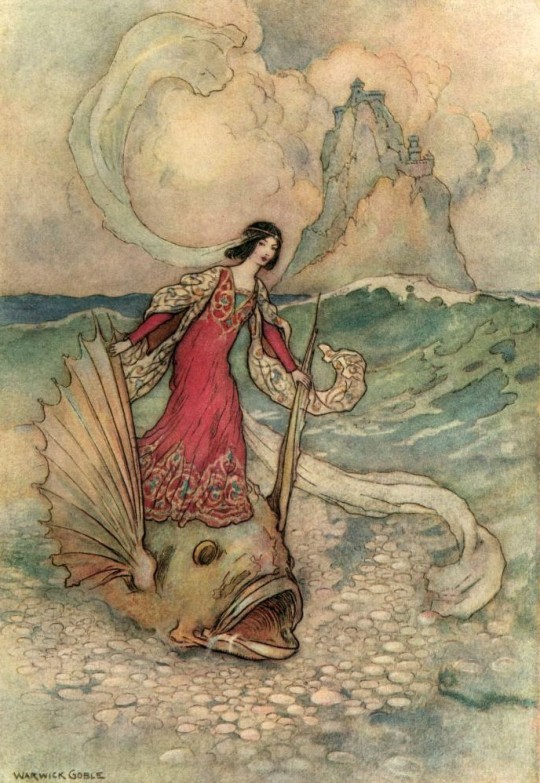
Rita riding on the Dolphin, from The Three Enchanted Princes for Stories from The Pentamerone by Warwick Goble (1911)
#warwick goble#art#illustration#golden age of illustration#1910s#1910s art#vintage art#vintage illustration#vintage#english artist#british artist#books#book illustration#fairy tale#fairy tales#fairytale art#italian folklore#classic art
677 notes
·
View notes
Text
Folk Witch Tip #1
Just to be sure, double cleanse your place spiritually. just like we double cleanse our face at night or double wash our hair. I’m not talking about complex cleansing rituals, just pouring table salt on liminal spaces and saying a prayer while vacuuming is more than enough.
#witchblr#witchcraft#witch community#witch#witches of tumblr#witches#folk magic#folk witch#folk spellcraft#italian folk magic#folk witchcraft#folk christianity#folk catholicism#italian folklore#folklore#witch tips#traditional witchcraft#budget witchcraft#witchy tips
110 notes
·
View notes
Text
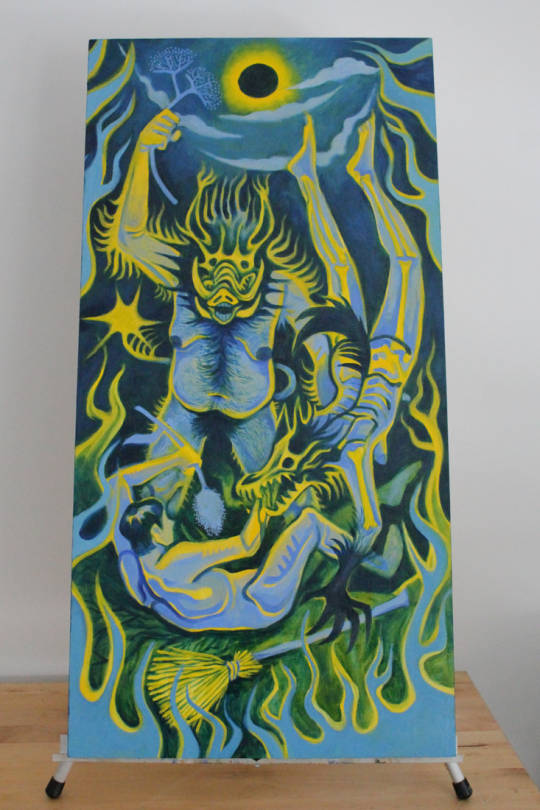
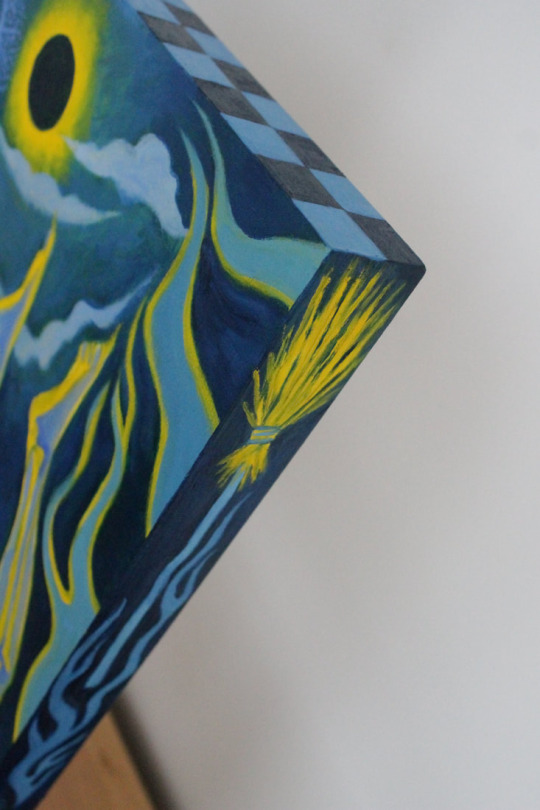
i thought i had posted the final painting here but i had not!
unfortunately i only have quite blurry pictures right now but i may update this post in the future when i receive the piece back from the gallery.
the night battle, 30"x15", oil on cradled panel, made for a gallery show themed around the occult
“The Night Battle” depicts the Friulian benandanti, the “Good Walkers”, benevolent witches that travel out of their bodies at night to battle against the malevolent malandanti, in the hopes of bringing about good crops. The benandanti occasionally took the form of animals, and occasionally overlap with werewolf stories.
I primarily connect with my Italian ancestry through folklore, and the stories that were passed down from my family were stories with a cisheteronormative, Roman Catholic lens. In response I wanted to make a piece in defiance to those stories where queer and trans bodies may bring about a bountiful future harvest.
78 notes
·
View notes
Text

La Befana: an Epiphany tradition in Italy
The Epiphany is a Christian festival celebrating the arrival of Jesus Christ into the world, the moment when the three Wise Men came to Jerusalem from Asia, Europe and Africa to worship the incarnation of God. For Western denominations, it is celebrated on 6 January, exactly 12 days after 25 December, Christmas Day. The etymology of the Epiphany is to be found in ancient Greek, used to indicate a divine manifestation or apparition.
The pagan meaning of Epiphany, however, is linked to propitiatory rites for agriculture between the 10th and 6th centuries B.C. and, between ancient Rome and the Middle Ages, to Roman winter solstice celebrations that continued for 12 days after 25 December, with each day representing one of the 12 months of the year.
In Italian folklore, the Befana is an old woman or witch who delivers gifts to children throughout Italy on Epiphany Eve (the night of January 5) in a similar way to Santa Claus or the Three Magi Kings.

In popular folklore, the Befana visits all the children of Italy on the eve of the Feast of the Epiphany to fill their socks with candy and presents if they are good, or a lump of coal or dark candy if they are bad. In many poorer parts of Italy and in particular rural Sicily, a stick in a stocking was placed instead of coal.
She is usually portrayed as a hag riding a broomstick through the air wearing a black shawl and is covered in soot because she enters the children's houses through the chimney.
Photo taken in Motta Filocastro (Calabria, Italy) by @mimmolarox
Follow us on Instagram, @calabria_mediterranea
#befana#epiphany#calabria#italy#italia#south italy#southern italy#folklore#italian folklore#hag#witch#italian#traditions#tradition#europe#6 january#mediterranean
46 notes
·
View notes
Text
Italian folk magic - animal correspondences & symbolic meanings
In Italian spirituality and folklore, there are various animal correspondences and symbolic meanings. Here are a few examples:
The wolf is a common symbol in Italian folklore and is often associated with strength, cunning, and loyalty. In some traditions, the wolf is also seen as a protective spirit and a guide through the wilderness.
The snake is associated with both positive and negative symbolism in Italian spirituality. On one hand, the snake can represent wisdom, transformation, and healing. On the other hand, it can also represent deception, danger, and evil.
The fox is often seen as a trickster figure in Italian folklore and is associated with cleverness, adaptability, and quick thinking. In some traditions, the fox is also associated with the god Mercury and represents communication and commerce.
The owl is associated with wisdom, intuition, and the mysteries of the night. In some Italian traditions, the owl is also seen as a symbol of death and the afterlife.
The bear is a symbol of strength, courage, and protection. In some traditions, it is also associated with the goddess Diana and represents fertility and the power of the natural world.
The horse is associated with freedom, power, and nobility. In some traditions, it is also associated with the goddess Epona and represents fertility, abundance, and the protection of travelers.
The bee is a symbol of hard work, community, and the sweetness of life. In some Italian traditions, it is also associated with the goddess Venus and represents love and beauty.
The cat is associated with independence, mystery, and intuition. In some traditions, it is also associated with the goddess Bastet and represents protection, fertility, and the power of the feminine.
The boar is a symbol of courage, tenacity, and strength. In some traditions, it is also associated with the god Mars and represents protection, fertility, and the power of the warrior.
The rooster is associated with vigilance, courage, and the dawn. In some Italian traditions, it is also associated with the god Apollo and represents prophecy, music, and the power of the sun.
#italian folk magic#italian folklore#italian magick#italian magic#italian witchcraft#generational magic#generational witchcraft#witchcraft#witchblr#grimoire#book of shadows
183 notes
·
View notes
Text
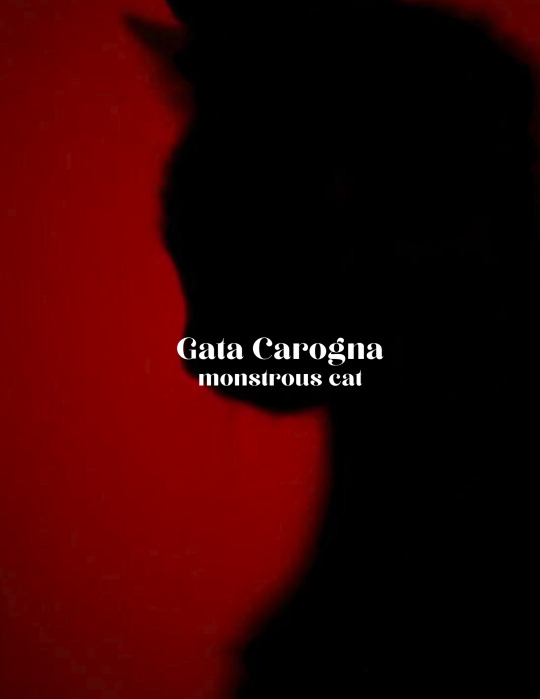
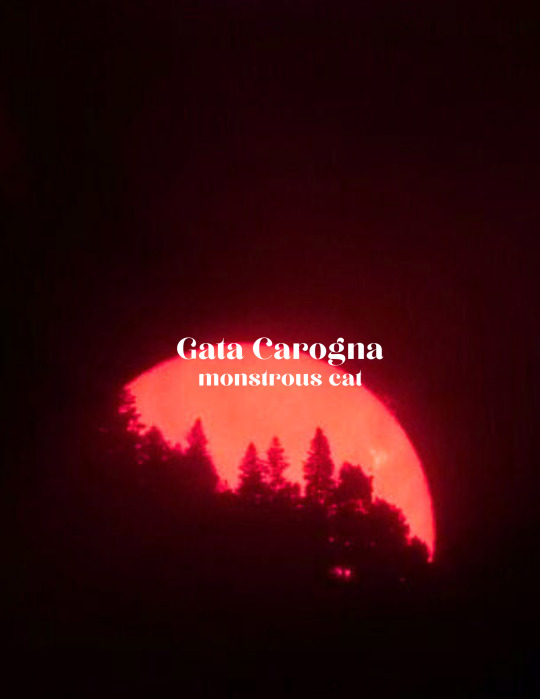
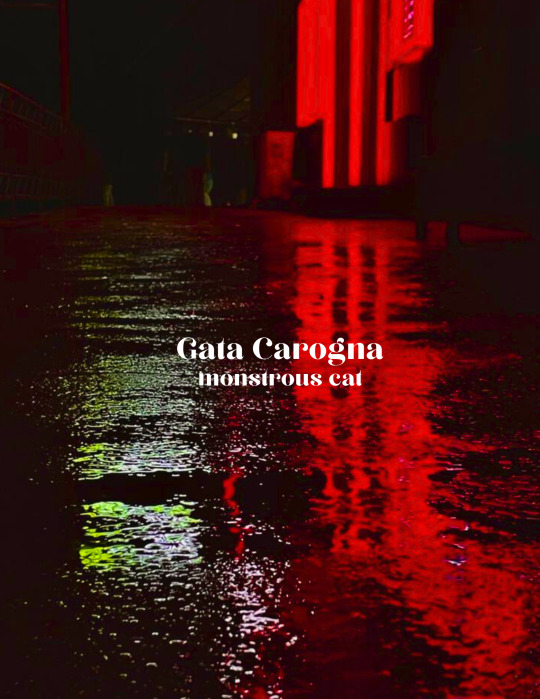

day 21 of horror mythology: gata carogna
in the folklore of lombardy, the gata carogna is a monstrous animal analogous to the mammone cat, which infests the dark alleys of the cities. she looks like a big red cat, with shaggy fur and angry eyes, who attack children to steal their souls.
63 notes
·
View notes
Text
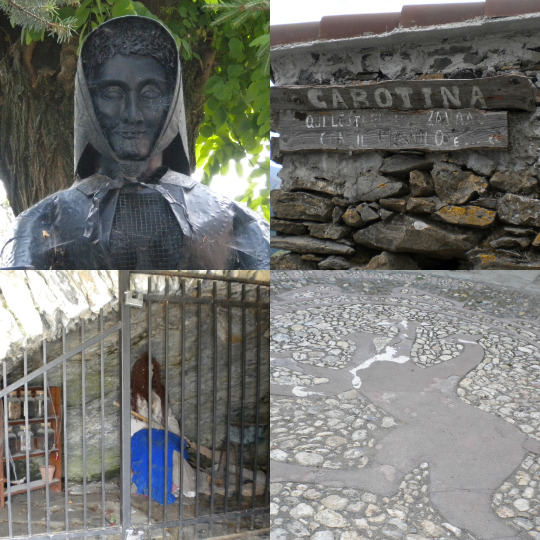
Italian witch trials
Triora is a small village located in the region of Liguria in Italy, the town is known as the “Italian Salem” because of the famous Witch’s trial occurred there in the 16th century.
It was 1587 when after two years of famine the village leaders and the elder’s council decided that such a tragedy was the result of the evil doing of a bunch of local women, all accused of mingling with the devil. The accused women were mainly prostitutes or poor women emarginated in the Cabotina, a district populated by meager people located outside the town walls.
Nobody complained when a bunch of wretched women without a penny were accused of witchcraft, but things quickly changed when the accusations spread like oil and invested the wealthier women of Triora’s society.
Genoa sent over to Triora Giulio Scribani, a former local magistrate, nominated special commissioner for the case. Scribani sent thirteen women to the prison of Genoa and raged throughout the area opening new cases and causing innocent women to die. Genoa, the Inquisition, and the Church itself tried to intervene and to stop the trials but Scribani went ahead; in Triora and neighboring villages such as Andagna, Bajardo, and Montalto Ligure the deaths of many innocent people were recorded.
In 1589 after two years of persecutions the trials were closed by the Inquisition, little is known about what happened to the women that were sent to Genoa, but dozens were the women imprisoned, and those who did not burn to death, died from the torture they endured.
Historians agree in saying that the reasons behind the accusations, were possibly that local landowners wanted to rise food prices to increase their income causing people to become unable to buy food to sustain themselves and their families. Blaming the death of hunger-stricken people on witchcraft was a perfect way out.
Today the town honor the memory of the events with a museum dedicated to the witch hunt, trials and witchcraft, but the geographic area is still connected with its mysterious and magical past.
The heraldry symbol of the town is Cerberus, the infernal hound, the name Triora in fact comes from the Latin Tria Ora which means three mouths. Triora’s main church, the Collegiata it’s believed to be constructed on a previous pagan temple, a Fanum. Evidence of earlier pagan cults is also represented by an ancient menhir situated in the Mezzaluna Pass. But the area is full of places considered witching spots, natural spaces where it’s believed that withes organized their sabbaths, like the lake Lagodégnu, the field Ciàn der Préve, the fountain Campomavùe and the nearby walnut tree. These places, with the ancient Cabotina, can still be visited today and recall to the primeval traditions of Italian witchcraft. The village also organizes an annual festival dedicated to witchcraft and paganism.
#witchcraft#witchblr#italianwitch#strega#italian witchcraft#witches of tumblr#witch trials#Triora#History of witchcraft#italy#witch hunt#italian folklore#stregheria#traditional witchcraft#liguria#my pics
98 notes
·
View notes
Text


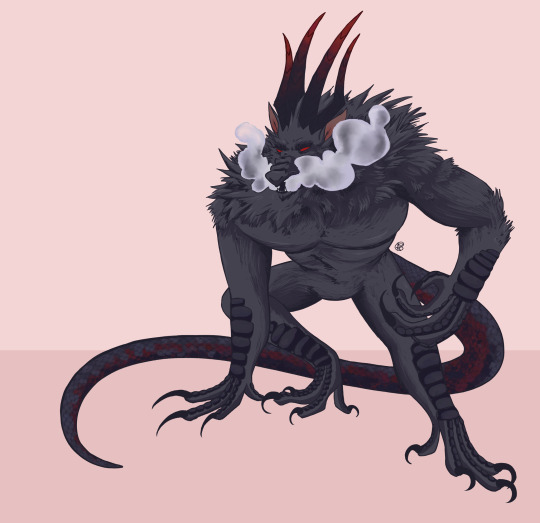

Sharing my final for my character design class! We had to create three designs based on one culture, and I chose Italy! Here’s La Befana, a villager folk dancer, and the demon Aamon.
49 notes
·
View notes
Text

A monstrous cat. Hidden just around the corner, off the main streets and in the dark of rarely trodden passages. She lurks, waiting for her prey to wander unwittingly into her clutches.
#BriefBestiary#bestiary#digital art#fantasy#folklore#legend#myth#mythology#monster#gata carogna#italian folklore#italian legend#bergamo legend#cremona legend#lombardy legend#monster cat#soul eater
13 notes
·
View notes
Text
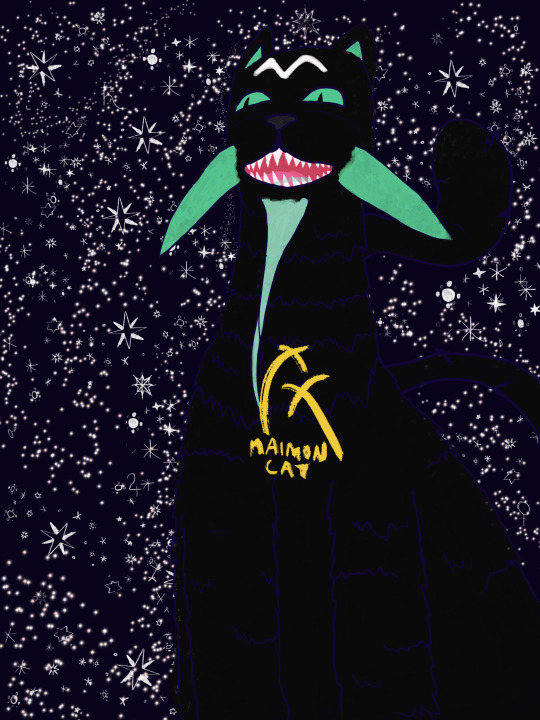
Gatto Mammone, o Re dei Gatti, è una creatura del folklore italiano, una delle poche che si trova in più o meno tutta Italia. È descritto come un enorme gatto demoniaco, dal pelo nero con una M bianca sulla fronte. Appare in alcune fiabe e leggende, tra l’altro nelle versioni italiane de “La ragazza cortese e quella scortese” , come ne “La fiaba dei gatti”, raccolta da Piero Pellizzari e aggiunta alle Fiabe Italiane di Calvino. Nel Medioevo era sinonimo di qualunque mostro o creatura leggendaria, oggigiorno però è solo un vecchio spauracchio dimenticato. Dino Buzzati scrisse un’articolo su di una signora anziana, che parlò del suo incontro col criptide. Per poi disegnarne una caricatura. È possibile che sia ispirato ad una divinità fenicia della fertilità, Maimone, ma di sicuro è stato unito al demone Mammona biblico e alla parola araba Maymun, scimmia.
Ho voluto postarlo qui il Martedì grasso, dato che talvolta è in qualche modo collegato con la stagione del Carnevale (specialmente in Sardegna). Qui eccovi alcuni schizzi concettuali che ho fatto di lui per il fumetto "Tales of the Otherfolk" di @zal-cryptid (molto ispirati al suo aspetto nella pellicola del 2019 "La famosa invasione degli orsi in Sicilia"):
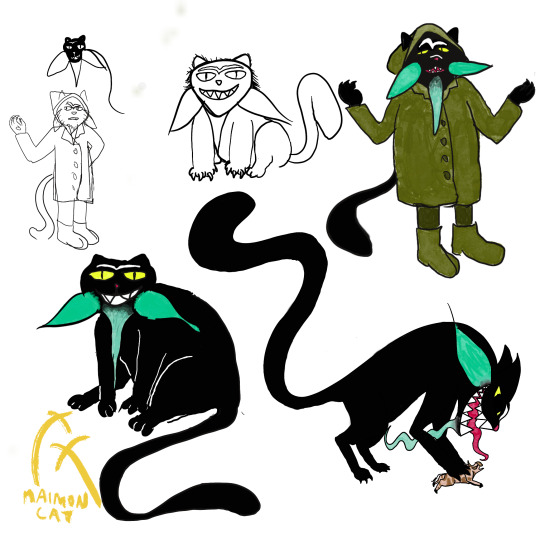
The Mammon Cat, or Catking, is a creature of Italian folklore, one of the few found in all of Italy. He’s described as a giant demon cat, with black fur and a white M on his forehead. He appears in some legends and fairy tales, like italian versions of “The kind and unkind girls”, as the “the tale of the cats” collected by Piero Pellizzari and included into Italo Calvino’s Italian FolkTales. In the Middle ages he was a synonym of any weird or scary creature, but today he’s only a half forgotten boogeyman. Dino Buzzati wrote an article where an old woman who spoke of her encounter with the cryptid. And then proceded to draw a caricature of it. It’s possible that the mammon cat is based on a phoenician fertility god, Maimone, but he was certainly united with the biblical demon Mammon and the arabic word for monkey, Maymun.
I decided to post this here on Mardi Gras (or Shrove Tuesday), since at times he's connected with the Carnival season (especially in Sardinia). Up there are also some concept sketches for @zal-cryptid 's webcomic "Tales of the Otherfolk". Very much inspired by his depiction in the 2019 movie "the Bears' famous invasion of Sicily".
Der Mammonkater, oder König der Katzen, ist ein Fabelwesen der italienischen Folklore, eins der Wenigen, die in ganz Italien verbreitet sind. Er ist als riesiger Teufelskater, mit schwarzem Fell und einem weissen M auf der Stirn. Er erscheint in einigen Märchen und Legenden, unter anderem in den italienischen Varianten von den „Geschichten von artigen und unartigen Mädchen“ (also Frau Holle), wie in „das Märchen von den Katzen“, das von Piero Pellizzari gesammelt und in Italo Calvinos Italienische Märchen mitgezählt wurde. Im Mittelalter war er das Stichwort für seltsames oder ungeheuerliches Wesen, Heut zu Tage ist er aber nur ein halb vergessenes Schreckgespenst. Dino Buzzati schrieb einen Artikel über eine Frau, die von ihrem Erlebnis mit dem Kryptiden erzählte. Danach zeichnete er eine Karikatur davon. Es ist möglich, dass er auf einem phönizischen Fruchtbarkeitsgott, Maimone, beruht, aber er wurde sicherlich mit dem biblischen Mammon und dem arabischen Wort für Affe, Maymun, vereint.
Ich wollte es am Fastnachtdienstag posten, da er manchmal (vor allem in Sardinien) mit der Faschingszeit verbunden wird. Oben noch ein Paar Skizzen von ihm für @zal-cryptid s Webcomic "Tales of the Otherfolk". Designweise sehr an seiner Erscheinung im 2019er Film "Königreich der Bären" angelehnt.
#my art#my artwork#Gattomammone#Gatto mammone#gatto nero#italian#italian horror#italian folklore#italian fairy tales#Italian folk tales#mammon#mammoncat#Mammon cat#Demon cat#digital art#digital drawing#concept art#old art#italian legend#cryptid#italian cryptid#La famosa invasione degli orsi in Sicilia#Mammonkater#monster#fabelwesen#mostro#boogeyman#la fiaba dei gatti#The tale of the cats#Das Märchen von den Katzen
8 notes
·
View notes
Text
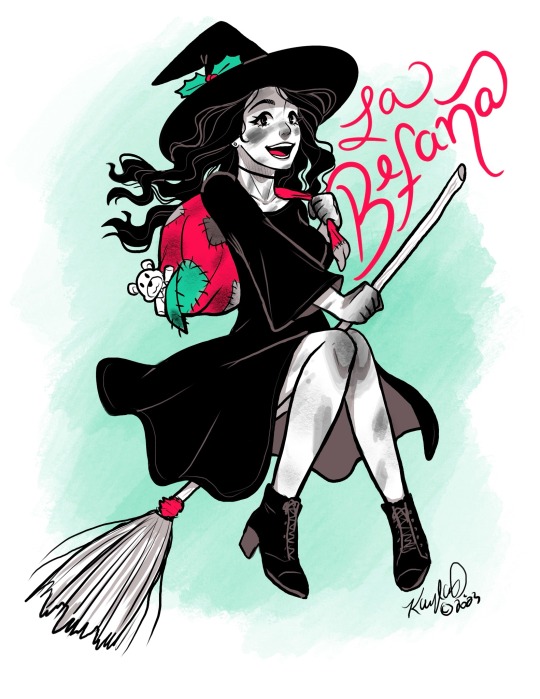
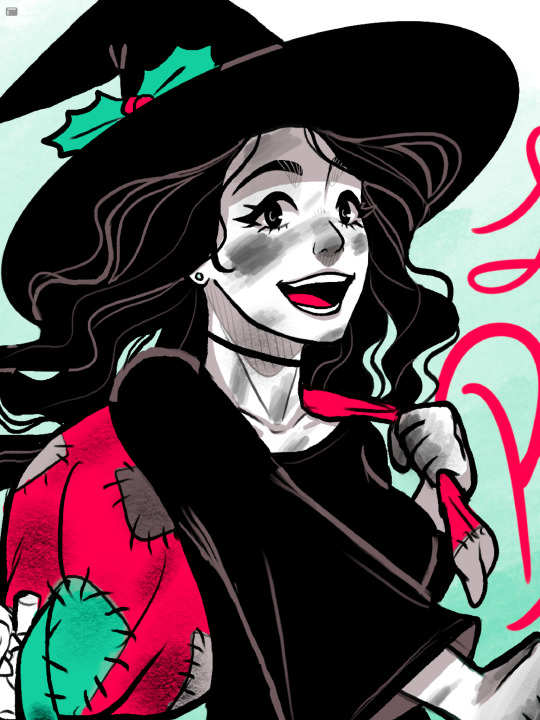
Last Christmas, my Sicilian grandmother told us about La Befana, the Christmas Witch, and I’ve been meaning to draw her so I squeezed her in before the holidays. In Italian/Sicilian folklore, she flys on a broomstick on Epiphany Eve (January 5) and delivers toys to good children or a lump of coal or a stick to bad children. Like Santa, she travels down the chimney which is why she’s covered in soot, and it’s said that she’ll even sweep the floor with her broomstick before she leaves. And instead of cookies and milk, families would leave wine and a few morsels of food for her. She’s usually depicted as a smiling old woman, but I decided to draw a young version of her….Also happy winter solstice!
10 notes
·
View notes
Text




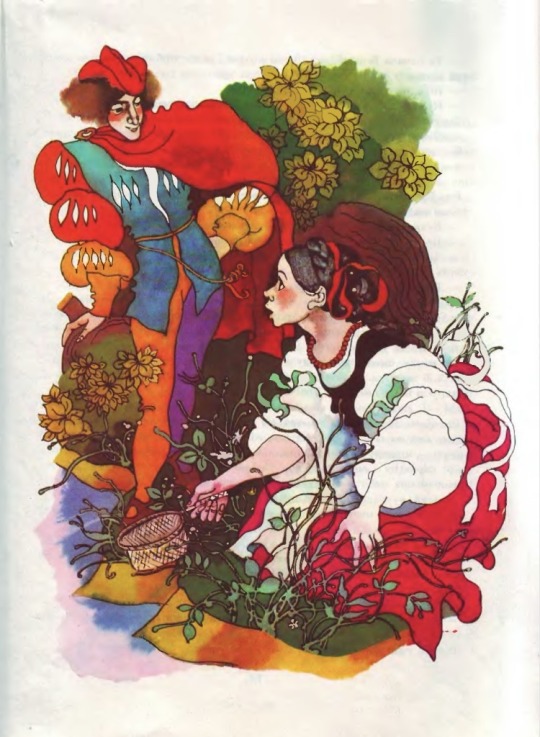
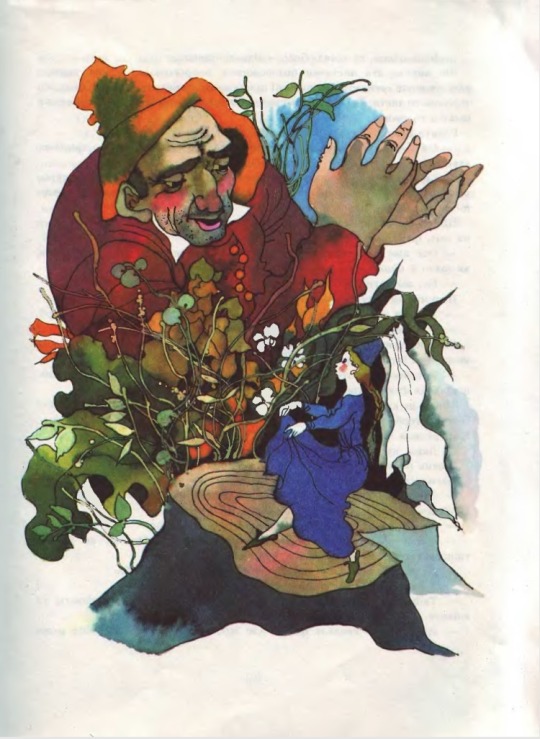

Італійські народні казки / Italian folk tales
Artist: Kim Svitlana
“Veselka” publishing, 1986
#ukrainian books#ukrainian artist#italia#italian folklore#україна#ukrainian art#folk tales#literature
104 notes
·
View notes
Note
I am very interested in what you said about blessing people around the person who did me dirty so they can see the true nature of the person how do I do that, if you have a recipe please share it with me. I also want to know if this will work with someone who has sent curses to me?
My go-to are prayers. Pray to your gods, pray to the spirits you work with. Ask for their blessing and tell them who is it for and why (saying “All [Target’s name]’s acquaintances” works just as well when you don’t have a specific acquaintance in mind). I usually offer the spirits something before and after this is done.
It would work on anyone, but if you’re specifically concerned about reversing a hex, this is not the way to go.
#witchblr#witchcraft#witch community#witch#witches of tumblr#witches#pagan witch#folk witch#folk witchcraft#folk spellcraft#folk christianity#folk catholicism#italian folk magic#folk magic#italian folklore#spirit work#curses and hexes#baneful witch#baneful magic#spellcraft#spellwork#spellcasting
37 notes
·
View notes
Text
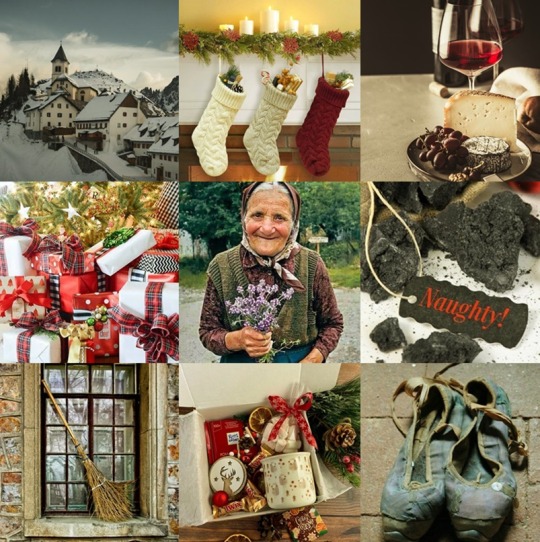
Befana Aesthetic
In Italian folklore, the Befana is an old woman or witch who delivers gifts to children throughout Italy on Epiphany Eve (the night of January 5) in a similar way to Santa Claus or the Three Magi Kings.
In popular folklore, the Befana visits all the children of Italy on the eve of the Feast of the Epiphany to fill their socks with candy and presents if they are good, or a lump of coal or dark candy if they are bad. Being a good housekeeper, many say she will sweep the floor before she leaves. To some the sweeping means the sweeping away of the problems of the year. The child's family typically leaves a small glass of wine and a plate with a few morsels of food, often regional or local, for the Befana.
She is usually portrayed as a hag riding a broomstick through the air wearing a black shawl and is covered in soot because she enters the children's houses through the chimney. She is often smiling and carries a bag or hamper filled with candy, gifts, or both.
Merry Christmas to all of you, happy holidays if you don't celebrate Christmas.
9 notes
·
View notes
Text

Nox Perpetua, an illustration i did for an exhibition, inspired by the italian folklore around St. Lucy
10 notes
·
View notes
Text
Italian folk magic basics
Italian witchcraft, also known as Stregoneria, is a form of traditional witchcraft that has its roots in ancient Italy. Here are some basics of Italian witchcraft:
The practice of Italian witchcraft is often passed down through family traditions, and many practitioners are born into it.
The practice involves working with spirits, ancestors, and deities, and often involves honoring the elements of earth, air, fire, and water.
Italian witchcraft is centered around the idea of "la vita e bella" (life is beautiful), and emphasizes the importance of finding joy and beauty in everyday life.
The use of natural materials, such as herbs, stones, and crystals, is an important part of Italian witchcraft. These materials are often used in spells and rituals, and are believed to have specific properties and energies.
The practice of divination, or seeking guidance from the spiritual realm, is also an important part of Italian witchcraft. This may involve reading tarot cards, using pendulums, or other methods.
The Italian witchcraft tradition places a strong emphasis on the importance of the sacred feminine, and many practitioners honor goddesses such as Diana, Hecate, and Isis.
Some Italian witchcraft traditions also incorporate elements of Catholicism, and may involve working with saints or angels as well as other spiritual beings.
Overall, Italian witchcraft is a deeply rooted and rich tradition that emphasizes connection with nature, spirit, and the sacred feminine. It is a beautiful and powerful practice that continues to inspire and captivate practitioners around the world.
#italian witchcraft#italian magic#italian magick#italian folklore#italian folk magic#book of shadows#grimoire#generational witchcraft#generational magic#witchblr#witchcraft
141 notes
·
View notes